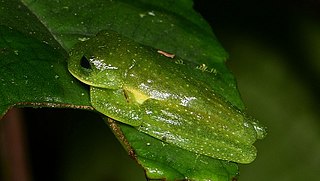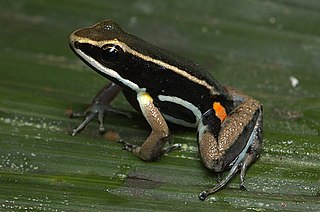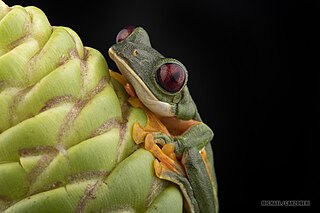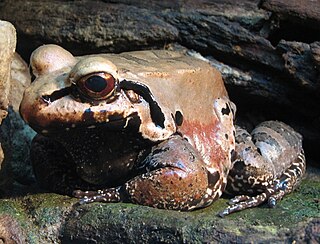
Centrolene ballux is a species of frog in the family Centrolenidae. It is known from a few disjunct localities on the Pacific versant of the Cordillera Occidental in southern Colombia and northern Ecuador. Common names golden-flecked glassfrog and Burrowes' giant glass frog have been coined for it.
Centrolene heloderma is a species of frog in the family Centrolenidae from the Andes in Colombia and Ecuador. It is also known as Pichincha giant glass frog or bumpy glassfrog.
Centrolene lynchi, also known as the Lynch's giant glass frog or Lynch's glassfrog, is a species of frog in the family Centrolenidae. It is found in the Risaralda Department on the Cordillera Occidental of Colombia and on the western Andes in the Pichincha, Cotopaxi, and Santo Domingo de los Tsáchilas Provinces, Ecuador. It is named after John Douglas Lynch, the herpetologist who collected the first specimens of this species. Centrolene scirtetes might be a junior synonym of this species.
"Centrolene" medemi is a species of frog in the family Centrolenidae. The species occurs in the Cordillera Oriental in the Tolima, Caquetá, and Putumayo Departments in Colombia and adjacent Napo in Ecuador. The generic placement of this species within the subfamily Centroleninae is uncertain. The specific name medemi honors Fred Medem, collector of the holotype. Common name Medem giant glass frog has been coined for it.

Centrolene prosoblepon is a species of frog in the family Centrolenidae, commonly known as the emerald glass frog or Nicaragua giant glass frog. This species can be found in Ecuador, Colombia, Panama, Costa Rica, Nicaragua, and Honduras. Its natural habitats are lowland tropical forests and montane cloud forests. It is a nocturnal species occurring in low vegetation in mature forests only. It is not considered threatened overall by the IUCN although deforestation and pollution are potential threats, as is chytridiomycosis.

Nymphargus anomalus is a species of frog in the family Centrolenidae. It is endemic to Ecuador and occurs on the Amazonian slopes of the Ecuadorian Andes in the Napo Province. Common name Napo Cochran frog has been coined for it.
Nymphargus balionota is a species of frog in the family Centrolenidae. It is found in the Andes of Colombia and Ecuador. Common names Mindo Cochran frog and mottled glassfrog has been coined for it.
Nymphargus chancas is a species of frog in the family Centrolenidae. Until recently it was only known from its type locality in the Lamas Province in Peru; however, it is now known to occur more widely in the northern San Martín Region of Peru, extending into the Cordillera del Cóndor in Zamora-Chinchipe Province, Ecuador.

Nymphargus cochranae is a species of frog in the family Centrolenidae. It is found in the lower Amazonian slopes of the Cordillera Occidental of Ecuador and adjacent Colombia, though the Colombian records require confirmation.
Nymphargus garciae is a species of frog in the family Centrolenidae, formerly placed in Cochranella. It is endemic to the eastern slopes of the Cordillera Central, Colombia. Its natural habitat is vegetation alongside streams in sub-Andean and Andean forests. It requires gallery forest for reproduction, and is therefore very sensitive to disturbance of this kind of habitat. It is threatened by habitat loss.

Cochranella mache, also known as the Mache glassfrog or Mache Cochran frog, is a species of frogs in the family Centrolenidae. It is found in the lowland forest and eastern slopes of Cordillera Mache–Chindul in the Esmeraldas Province, northwestern Ecuador, and in the western foothills of the Cordillera Occidental in Colombia.
Nymphargus nephelophila is a species of frogs in the family Centrolenidae, formerly placed in Cochranella. It is endemic to the Caquetá Department, Colombia, where it is known from the eastern versant of the Cordillera Oriental near Florencia. Its natural habitat is vegetation near streams in cloud forest, including secondary forest. Habitat loss is a threat to this species, but it is too little known to assess its conservation status.
Nymphargus posadae is a species of frog in the family Centrolenidae, formerly placed in Cochranella. It inhabits the eastern slopes of the Andes of Colombia, Ecuador, and northeastern Peru. It is reasonably common in Colombia but rare in Ecuador.
Nymphargus ruizi is a species of frog in the family Centrolenidae, formerly placed in Cochranella. It is endemic to Colombia where it is known from the western slopes of the Cordillera Occidental and the eastern slopes of the Farallones de Cali. Its natural habitats are sub-Andean forests next to streams. It is threatened by habitat loss caused by agricultural expansion, logging, human settlement, and water pollution.

Allobates femoralis is a species of frog in the family Aromobatidae. It is found in Bolivia, Brazil, Colombia, Ecuador, French Guiana, Guyana, Peru, and Suriname. Its natural habitat is tropical lowland forests.
Hyloxalus awa is a species of frog in the family Dendrobatidae. It is endemic to Ecuador and known from the western Andean slopes and the western Pacific lowlands.
Hyloxalus bocagei is a species of frog in the family Dendrobatidae. It is found on the northeastern side of the Andes in Ecuador and in Colombia. The specific name bocagei honors José Vicente Barbosa du Bocage, a Portuguese zoologist. Common name Bocage's rocket frog has been coined for this species.
Hyloxalus lehmanni is a species of frog in the family Dendrobatidae. It is found widely in Colombia from Antioquia southwards to northern Ecuador.

The gliding tree frog is a species of frog in family Phyllomedusidae. It is found in Colombia, Costa Rica, Ecuador, and Panama. Other common names are the gliding leaf frog, Spurrell's leaf frog, and pink-sided tree frog. The specific name, spurrelli, is in honour of British zoologist Herbert George Flaxman Spurrell.

The smoky jungle frog is a species of frog in the family Leptodactylidae. It is found in Bolivia, Brazil, Colombia, Ecuador, Costa Rica, Panama, French Guiana, and Peru. Its natural habitats are tropical and subtropical moist broadleaf forests, subtropical or tropical swamps, subtropical or tropical moist montane forest, rivers, freshwater marshes, intermittent freshwater marshes, and aquaculture ponds.









